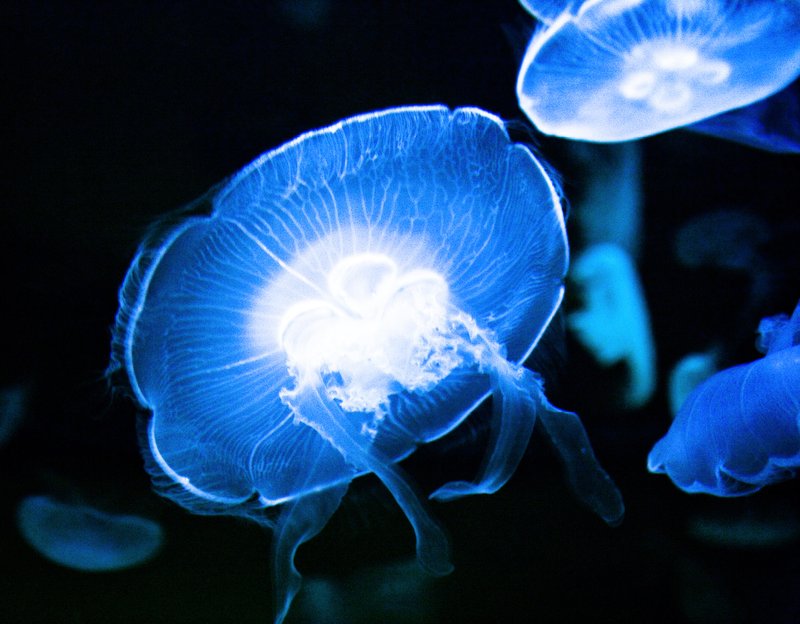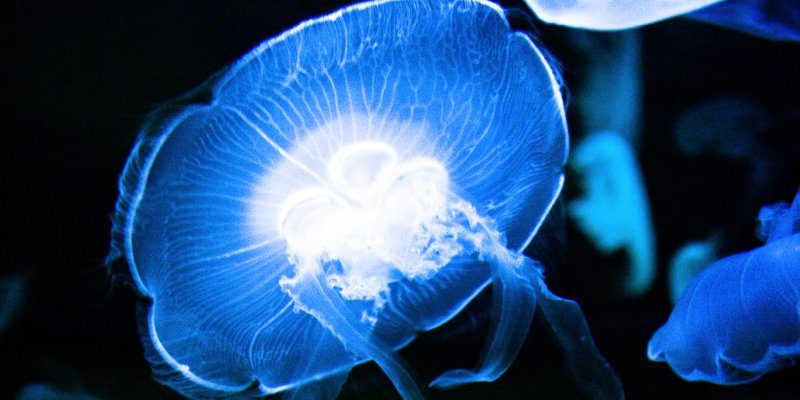
Imagine diving into a vibrant reef and watching jellyfish pulse gently, almost like they’re dancing. Their adaptations are clever little tricks that help them find food, avoid predators, and reproduce successfully. Let’s take a closer look at what makes jellyfish so remarkable beneath the waves.
1. The Art of Floating: A Unique Body Structure
Jellyfish have a body design that’s all about efficiency. They’re mostly made up of water—around 95%. This high water content makes them light and allows them to float easily. Picture a balloon filled with water; it’s buoyant and can drift along with the currents.
Their bell-shaped body, or medusa, helps them navigate their environment. When they contract their bell, they can push water behind them, propelling forward in a delicate ballet. This movement isn’t just for show; it’s an efficient way to catch the currents of the ocean.
What’s even cooler is their tentacles. They hang out like fishing lines, equipped with specialized cells called cnidocytes. When prey, like tiny fish or plankton, brush against these tentacles, the jellyfish can quickly sting and immobilize them. It’s a clever way to make the most of their soft, gelatinous bodies while snagging a meal.
2. A Transparent Life: Camouflage and Defense
Being nearly transparent is another awesome adaptation. In the deep blue ocean, jellyfish blend in with their surroundings. This makes it harder for predators, like larger fish, to spot them. Imagine wearing an invisibility cloak while walking down the street—pretty handy, right?
But that’s not their only trick. Some jellyfish, especially those in tropical waters, have a surprising bonus—they can glow! This bioluminescence can disorient predators or attract mates. It’s like having a sparkle in your eye when you’re trying to catch someone’s attention.
When threatened, jellyfish can also employ a nifty escape tactic. They can quickly contract their bell and shoot away from danger, using the ocean currents to their advantage. So, they not only look fantastic but also know how to stay safe.
3. Reproducing in Style: A Two-Part Lifecycle
Jellyfish have a unique reproductive strategy that involves both sexual and asexual reproduction. In the sexual phase, adult jellyfish release eggs and sperm into the water, resulting in fertilized larvae. It’s a bit like a party where everyone is invited, but not everyone ends up in the same place.
Once fertilized, the larvae settle on a surface and develop into polyps, which can clone themselves. This asexual reproduction means that one polyp can produce many jellyfish. It’s an efficient method to increase their numbers, especially in favorable conditions.
As the polyps mature, they eventually transform back into jellyfish, completing their lifecycle. This two-part system allows them to adapt to their environment and increase their chances of survival.
4. Feasting with Ease: A Simple Diet and Hunting Strategy
Jellyfish have a simple yet effective diet largely consisting of plankton, small fish, and even other jellyfish. Their hunting method is fascinating. Instead of actively chasing down prey, they wait patiently, allowing their tentacles to drift through the water.
When a tiny fish or plankton swims too close, boom! Those stinging cells are activated, paralyzing the prey almost instantly. It’s like setting a trap and letting dinner come to you, which is perfect for an animal that doesn’t expend much energy.
Moreover, jellyfish don’t need to hunt continually. Their ability to absorb nutrients directly from the water, like a sponge, helps them sustain during lean times. This passive feeding strategy is one reason they can thrive in diverse environments, from coastal areas to the open ocean.
5. Thriving in Different Environments: Adaptability
Jellyfish are true environmental champions. They can be found in oceans all over the world, from warm tropical waters to chilly polar regions. This adaptability is significant for their survival.
One key factor is their ability to tolerate various salinity levels. Certain species can thrive in more saline waters while others can live in brackish or even fresh waters. Picture a plant that can grow in sandy soil or clay—it’s all about being flexible.
Additionally, some jellyfish can tolerate low oxygen levels, which is increasingly important as ocean conditions change due to climate change and pollution. Their resilience means that they’ll likely continue to persist even as other marine species struggle.
6. The Role of Jellyfish in the Ecosystem
Although jellyfish might seem strange, they play a critical role in the marine ecosystem. They serve as food for various species, including sea turtles and certain fish. Without jellyfish, these animals could struggle to find adequate nutrition.
Moreover, jellyfish populations can influence the health of ocean ecosystems. As they feed on plankton, they help regulate that population, preventing overgrowth that can harm other marine life. In a way, they act as nature’s balance keepers.
Their presence, or absence, can indicate changes in ocean health too. When jellyfish populations bloom, it can signal alterations in water conditions, often related to human activity. So, even if they seem simple, they hold a complex place in the grand tapestry of ocean life.
7. Jellyfish and Climate Change: A Response to Shifting Oceans
With climate change causing shifts in ocean temperatures and chemistry, jellyfish have shown an incredible ability to adapt. Warmer waters often lead to blooms of jellyfish, as they thrive in conditions that can be unsuitable for many fish.
Increased nutrient runoff can also lead to more plankton, providing jellyfish with more food. This makes them resilient in changing environments, but it can also disrupt local ecosystems. Imagine the unexpected guest at a party who eats all the snacks and leaves the other guests feeling left out.
Understanding how jellyfish adapt can help us grasp larger environmental shifts. As ocean conditions continue to change, observing jellyfish populations might provide valuable insights into the health of our oceans.
In conclusion, jellyfish may seem like simple creatures, but their adaptations are anything but basic. From their unique body structure and clever feeding strategies to their ability to thrive in various environments, they showcase incredible resilience in our oceans. By exploring these adaptations, we not only appreciate the jellyfish more but also gain insights into the health of our aquatic ecosystems. So, the next time you see a jellyfish, remember, there’s a lot more going on beneath that transparent surface!

